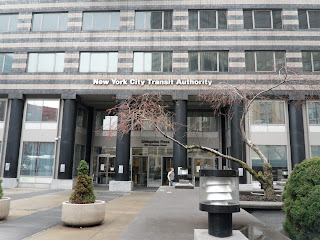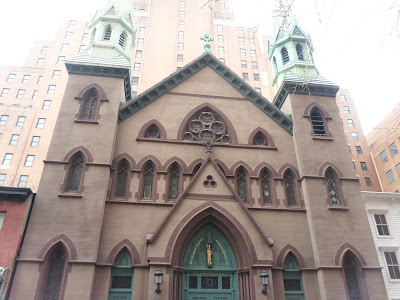|
Barclays Center
Barclays Center in a distant view. |
|
|
|
In 2012, the neighborhood of Downtown Brooklyn welcomed a brand new indoor arena, Barclays Center. The construction of the arena created over 10,000 jobs and they welcome over 10,000 people in their expected 200 events this year.
Barclays Center is connected to the very busy Atlantic Avenue terminal, which is connected to nine different subway lines, bringing attraction to the growing neighborhood.
Atlantic Avenue Terminal
 |
| The restored original Atlantic Avenue entrance. Today, it is an artistic skylight for the new Atlantic Avenue terminal underneath it. |
 |
| The entrance in 1908. (Taken from the Library of Congress archives) |
 |
| The entrance in its worst state in 1997. |
|
|
The Atlantic Avenue terminal connects the B, D, N, Q, R, 2, 3, 4, & 5 lines. The Atlantic Avenue terminal has served over 10 million passengers in 2011 alone.
The Williamsburgh Savings Bank
 |
| The Williamsburgh Savings Bank building on a cloudy day. |
 |
| The Williamsburgh Savings Bank in the 1930's. |
The Williamsburgh Savings Bank stands today at 512 feet high as the second tallest building in Brooklyn. One of its most important features is the still functioning, four faced clocks at the top of the building, which as 17 feet tall, each, makes the clock one of the largest in the world. It was completed in April 1929, and was later used a dentists' office. It was officially declared a landmark in 1977 and in 2005 it was converted into a luxury condominium.
Brooklyn Academy of Music
 |
| BAM's Peter Jay Sharp Building |
The Brooklyn Academy of Music, or BAM, is a performing arts academy located in Downtown Brooklyn. It is considered to be one of the most important venues in Brooklyn considering its long history. Many famous artists have performed at BAM, such as Mark Twain, Sarah Bernhardt and many more.
The Dime Savings Bank of Brooklyn
The Dime Savings Bank of Brooklyn was a bank that operated from 1859 to the late 20th century. Their headquarter is located in 9 Dekalb Avenue and in 1994, it became a New York City landmark.
IHOP!!!!
 |
| Pancakes n' shit. |
In 276 Livingston Street is the famous iHOP restaurant. They serve hot bananas in warm pancakes.
The Brooklyn Tabernacle
"The Brooklyn Tabernacle is a multicultural, non-denominational church in the heart of downtown Brooklyn. Folks come from all over the world to see the 285-voice, six-time Grammy
Award-winning Brooklyn Tabernacle Choir, one of the nation's most
celebrated gospel choirs.The gloriously renovated 1918 building is the fourth-largest theatrical
space in the five boroughs, and seats nearly 4,000 for each service."
The Old Brooklyn Fire Headquarters
 |
| The old Brooklyn fire headquarters in 2012 |
 |
| The old Brooklyn Fire Headquarters in 1914. (source: BPL) | | | |
The Brooklyn Fire Headquarters in 367 Jay St was built in 1892. It was used by the original Brooklyn firefighters until 1898 when Brooklyn became a part of the greater New York City. Afterwards, it became an actual firehouse until the 1970's. In 1972 it was placed in the National Register of Historic Places. The building was leased for a time to Polytechnic University, and then was sealed up and empty until 1987 when the city approved for a plan to convert the building into a low income housing building. However, today, the building is in poor condition and in need for repair.
NYC Transit Authority Headquarters
Located on
130 Livingston Street, the NYCTA is one of the most important buildings in the entire city due to the fact that without it, we would not have public transportation. The New York City Transit Authority (trading as MTA New
York City Bus/Subway and Access-A-Ride) provides bus, subway, and
paratransit service throughout New York City.
Brooklyn Law School
Brooklyn Law School was founded in 1901 and as of 2012, it has about 1,400 students. The employment rate for the Class of 2010 was 88.1%. Alumni have relocated to 49 states and over 25 countries after graduation.
Municipal Building of Brooklyn
The building was designed by McKenzie, Voorhees & Gmelin and completed
in 1924 at a cost of $5,800,000. It houses many City
offices including the City Clerk (where marriage licenses are obtained),
and offices for the Departments of Buildings, Probation, Finance,
and Environmental Protection.
Brooklyn Borough Hall
 |
| The rear entrance to the Brooklyn Borough Hall. |
 |
| Borough Hall in 1846 |
 |
| Brooklyn's oldest building, this porticoed Greek revival structure was designed by Gamaliel King, was built in 1846-51 as Brooklyn's city call. The cupola was added in 1898 when Brooklyn was consolidated into greater New York City, and the building became borough hall. Restored in 1989, it houses the offices of the Brooklyn borough president. -New York Landmarks Preservation Foundation 1990 |
|
 |
| Main entrance to the Brooklyn Borough Hall. |
New York State Supreme Court Building
Built in 1957 by Shreve, Lamb & Harmon which are interestingly, the same architects who built the Empire state building.
Federal Building and Post Office
In 270 Cadman Plaza East is the United States Bankruptcy Court for the Eastern District of New York. Construction for this building began in 1895 and it was completed in 1892. The U.S. General Post Office was designated a landmark by the New York City Landmarks Preservation Commission in 1966 and listed in the National Register of Historic Places in 1974. It now houses postal services as well as the U.S. Bankruptcy Court, the U.S. Trustee, and the Offices of the U.S. Attorney.
 |
| The older section of this romanesque revival building was begun in 1885 and completed in 1892. The plans of Mifflin E. Bell, the original architect were modified by William A. Freret, his successor as supervising architect of the treasury department, while the building was under construction. The addition was begun in 1930 and finished three years later. Plaque erected 1963 by The New York Community Trust. |
 |
| n 2009, the United States Congress enacted legislation renaming the building the Conrad B. Duberstein United States Bankruptcy Courthouse, in honor of chief bankruptcy judge Conrad B. Duberstein. |
 |
| Located in the new Municipal Center, this handsome 19th century structure provides a reminder of Brooklyn's past. Completed in 1891, the basement and first floors display handsome rock faced granite which contrasts with the smooth stone surface of the remainder of the building. The post office has a wealth of skillfully blended Romanesque revival, french and German renaissance details. A well-designed northerly extension to the building was complete in 1933 which adheres faithfully to the original portion facing Johnson Street. |
Korean War Veterans Plaza
New York City College of Technology
The New York City College of Technology is a four-year public college of technology which is also a City University of New York. It was established in 1946 and it currently has an enrollment of over 15,000 students in 62 technical and professional programs including several engineering technology fields as well as architecture, construction, nursing, and many more.
The Theodore Roosevelt Federal Courthouse
Joseph J. Jacobs Building
Polytechnic Institute of New York University
NYU Poly is the second oldest private engineering and technology institute in the United States. The Brooklyn campus includes the Institute's main campus, along with several technology-dependent companies such as Securities Industry Automation Corporation, as well as New York City Police Department's 911 Center, New York City Fire Department Headquarters and the U.S. technology and operations functions of JPMorgan Chase. In 1998, a Marriott Hotel was built adjacent to MetroTech.
The Catholic Church of Saint Boniface
Toren Condos
Department of Health
Long Island University-Brooklyn
LIU-Brooklyn is the University's first permanent site, established in 1926. It includes the former Brooklyn Paramount Theater, the world’s first theater built specifically for talking pictures. The New York Times recognized it as one of the most diverse campuses in the United States. It currently has
24,170 students.
Metropolitan Corporate Academy
Metropolitan Corporate Academy is a small, alternative high school for business/finance
and public services. It was once a civil war infirmary turned public elementary school, then high school.



































No comments:
Post a Comment